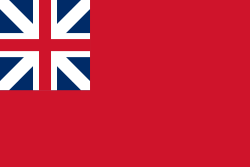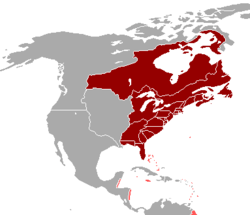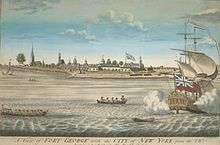British America
British America comprised the colonial territories of the British Empire in America from 1607 to 1783. These colonies were formally known as British America and the British West Indies before the Thirteen Colonies declared their independence in the American Revolutionary War (1775–1783) and formed the United States of America.[1] After the American Revolution, the term British North America referred to the remainder of Great Britain's Canadian possessions. That term was first used informally in 1783, but it was uncommon before the Report on the Affairs of British North America (1839), generally known as the Durham Report.
British America and the British West Indies | |||||||||||||||||||||
|---|---|---|---|---|---|---|---|---|---|---|---|---|---|---|---|---|---|---|---|---|---|
| 1607 — 1783 | |||||||||||||||||||||
 Flag of British America (after 1707) | |||||||||||||||||||||
 British colonies in America (red) and the island colonies of the British West Indies near the Caribbean Sea (pink) | |||||||||||||||||||||
| Status | Colonies of England (1607 — 1707) Colonies of Great Britain (1707 — 1783) | ||||||||||||||||||||
| Capital | Administered from London, England | ||||||||||||||||||||
| Common languages | English (de facto official) Spoken languages: English German French Spanish Dutch Swedish Finnish Welsh Cornish Irish Gaelic Scottish Gaelic Manks Ojibwe Indian languages | ||||||||||||||||||||
| Religion | Anglicanism, Protestantism, Lutheranism, Roman Catholicism, Judaism, American Indian religion, African religions | ||||||||||||||||||||
| Government | Constitutional monarchy | ||||||||||||||||||||
| Monarch | |||||||||||||||||||||
• 1607 — 1625 | James VI and I (first) | ||||||||||||||||||||
• 1760 — 1783 | George III (last) | ||||||||||||||||||||
| History | |||||||||||||||||||||
| 1607 | |||||||||||||||||||||
• Bermuda | 1614 | ||||||||||||||||||||
• Plymouth Council for New England (Massachusetts Bay Colony) | 1620 | ||||||||||||||||||||
| 1634 | |||||||||||||||||||||
| 1655 | |||||||||||||||||||||
| 1670 | |||||||||||||||||||||
• Treaty of Utrecht | 1713 | ||||||||||||||||||||
| 1763 | |||||||||||||||||||||
| 1775 — 1783 | |||||||||||||||||||||
| 1783 | |||||||||||||||||||||
| Currency | Pound sterling, Spanish dollar, colonial money, bills of credit, commodity money, and many local currencies | ||||||||||||||||||||
| |||||||||||||||||||||
| Today part of | |||||||||||||||||||||
The English established and expanded colonies in the 17th century. British America later gained large amounts of territory with the Treaty of Paris (1763), which ended the French and Indian War in America and the Seven Years' War in Europe. At the start of the Revolutionary War in 1775, the British Empire included 23 colonies and territories on the North American continent. The Treaty of Paris (1783) ended the war, and Britain lost much of this territory to the newly formed United States. In addition, Britain ceded East and West Florida to the Kingdom of Spain, which in turn ceded them to the United States in 1821. Most of the remaining colonies to the north formed Canada in 1867, with the Dominion of Newfoundland joining in 1949.
History

A number of English colonies were established in America between 1606 and 1670 by individuals and companies whose investors expected to reap rewards from their speculation. They were granted commercial charters by King James I, King Charles I, Parliament, and King Charles II. The London Company founded the first permanent settlement in 1607 on the James River at Jamestown, Virginia upstream from Chesapeake Bay. This was followed in 1620 when the Pilgrims established the Plymouth settlement in New England. English Catholics settled the Province of Maryland in 1634, under Cecilus Calvert, second Lord Baltimore.
A state department in London known as the Southern Department governed all the colonies beginning in 1660, as well as a committee of the Privy Council called the Board of Trade and Plantations. In 1768, Parliament created a specific state department for America, but it was disbanded in 1782 when the Home Office took responsibility for the remaining possessions of British North America in Eastern Canada, The Floridas, and the West Indies.[2]
North American colonies in 1775
The Thirteen Colonies that became the original states of the United States:

Colonies and territories that became part of Canada:
- Province of Quebec northeast of the Great Lakes (including Labrador until 1791)
- Nova Scotia (including New Brunswick until 1784)
- Island of St. John
- Colony of Newfoundland
- Rupert's Land
- North-Western Territory
- British Arctic Territories
Colonies and territories that were ceded to Spain or the United States in 1783:
- Province of East Florida (Spanish 1783–1823, U.S. after 1823)
- Province of West Florida (Spanish 1783–1823, U.S. after 1823)
- Indian Reserve (U.S. after 1783)
- Province of Quebec southwest of the Great Lakes (U.S. after 1783)
Colonies in the Caribbean, Mid-Atlantic, and South America in 1783
-
- Divisions of the British Leeward Islands
- Saint Christopher (de facto capital)
- Antigua
- Barbuda
- British Virgin Islands
- Montserrat
- Nevis
- Anguilla
-
- Island of Jamaica
- Settlement of Belize in British Honduras
- Mosquito Coast
- Bay Islands
- Cayman Islands
- Other possessions in the British Windward Islands
- Island of Barbados
- Island of Grenada
- Island of St. Vincent
- Island of Tobago (detached from Grenada in 1768)
- Island of Dominica (detached from Grenada in 1770)
See also
- Evolution of the British Empire
- British colonization of the Americas
- Colonial history of the United States
- Former colonies and territories in Canada
- British colonization of Australia
- British colonization of New Zealand
- British North America Acts
- British overseas territories
References
- "A Summary View of the Rights of British America — Thomas Jefferson".
- Foulds, Nancy Brown. "Colonial Office". The Canadian Encyclopedia. Retrieved 7 July 2018.
- "Rhode Island Royal Charter of 1663". sos.ri.gov. Secretary of State of Rhode Island. Retrieved 14 April 2011.
- "Charles II Granted Rhode Island New Charter". christianity.com. Christianity.com. 8 July 1663. Retrieved 14 April 2011.